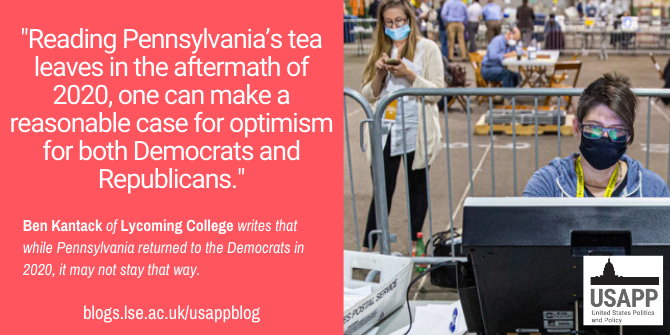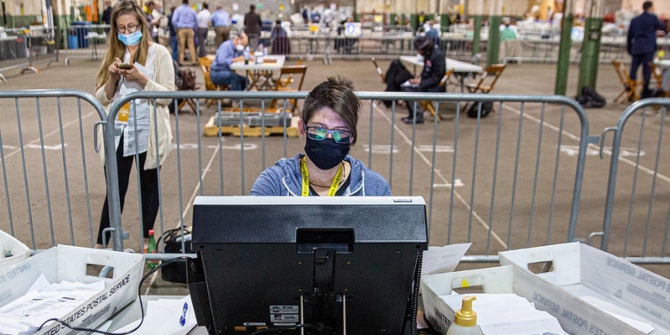 As it was key to Trump’s presidential election victory in 2016, winning Pennsylvania in 2020 helped secure the White House for Joe Biden in 2020. Ben Kantack writes that there are reasons for optimism for both Republicans and Democrats facing elections in the Keystone State in 2022 and 2024. On one hand, Biden may have re-established the Democrats’ “Blue Wall” in 2020. On the other, Biden’s slim electoral margin in Pennsylvania may not survive another candidate without his small-town connection to the state, or an increasingly left-leaning Democratic Party.
As it was key to Trump’s presidential election victory in 2016, winning Pennsylvania in 2020 helped secure the White House for Joe Biden in 2020. Ben Kantack writes that there are reasons for optimism for both Republicans and Democrats facing elections in the Keystone State in 2022 and 2024. On one hand, Biden may have re-established the Democrats’ “Blue Wall” in 2020. On the other, Biden’s slim electoral margin in Pennsylvania may not survive another candidate without his small-town connection to the state, or an increasingly left-leaning Democratic Party.
- Following the 2020 US General Election, our mini-series, ‘What Happened?’, explores aspects of elections at the presidential, Senate, House of Representative and state levels, and also reflects on what the election results will mean for US politics moving forward. If you are interested in contributing, please contact Rob Ledger (ledger@em.uni-frankfurt.de) or Peter Finn (p.finn@kingston.ac.uk).
In the runup to the 2020 presidential election, all signs indicated the Keystone State would live up to its nickname. Four years prior, Pennsylvania (together with Michigan and Wisconsin) had been one of three nails in the coffin of Hillary Clinton’s ill-fated 2016 presidential campaign, narrowly breaking Republican for the first time in three decades. Renowned election forecaster Nate Silver rated Pennsylvania as the most likely “tipping-point” in 2020, calling it a highly valuable target for Joe Biden and practically a must-win for Donald Trump. Even in a pandemic-constrained campaign, the two candidates held a combined 20 events in Pennsylvania in the final month before Election Day as the polling gap between them shrank to the smallest it had been all year.
Democrats saw Pennsylvania as vital to their bid to retake the White House. When they rallied around Biden as its nominee, a major argument in his favor was that he was uniquely capable of bringing blue-collar voters in the Rust Belt back into the Democratic fold. Biden, a native Pennsylvanian, frequently played up his roots during the campaign, characterizing the race as being “between Scranton and Park Avenue.” In response, Trump accused Biden of having “abandoned” his hometown. In the debates, both Trump and his running mate Mike Pence painted their Democratic counterparts as hostile to hydraulic fracturing (“fracking”), a controversial energy extraction process that has made Pennsylvania the country’s second-largest producer of natural gas. Wary of the potential electoral consequences, Biden and his running mate Kamala Harris refused to commit to a fracking ban.
On November 3, Trump took an early lead over Biden in Pennsylvania that turned out to be a mathematical mirage. Pennsylvania law prevented canvassers from counting absentee ballots until Election Day. When the dust finally settled, those absentee ballots – which Biden won by a three-to-one margin – proved more than enough to turn Pennsylvania blue, and no amount of eleventh-hour lawsuits by Republicans could upend that reality.
Where Biden Won Pennsylvania
In 1986, Democratic strategist James Carville summed up Pennsylvania’s political geography as Philadelphia and Pittsburgh with Alabama between them. Since then, Pennsylvania has continued to embody America’s urban-rural divide: Democrats dominate in cities, and Republicans fare better in the less populous countryside. Though Biden won only 13 of Pennsylvania’s 67 counties, seven of those were among the commonwealth’s ten most populous.
Biden flipped only two counties that had gone for Trump in 2016: Erie, in the northwest corner next to the Great Lake of the same name, and Northampton, on the New Jersey border. However, he improved dramatically on Clinton’s 2016 performance, outperforming her in a whopping 57 counties. Percentagewise, the biggest blue swings – both +4 percent – were in Cumberland County (near Harrisburg, the state capital) and rural Montour County. Votewise, Biden’s biggest net haul compared to 2016 came in suburban Montgomery County, where he beat Trump by 40,700 more votes than Clinton did (for perspective, Trump’s statewide margin of victory in 2016 was a mere 44,292 votes).
Two Ways of Looking at 2020
Hard data like these tell us what happened but not why or what’s next. Reading Pennsylvania’s tea leaves in the aftermath of 2020, one can make a reasonable case for optimism for both Democrats and Republicans.
Here’s the interpretation of 2020 Democrats would prefer: Biden’s recapture of Pennsylvania represents a return to electoral normalcy. The “Blue Wall,” long a bastion of Democrats’ presidential successes, is now firmly reestablished. 2016 was an aberration, brought on by a historically unpopular Democratic candidate whose penchant for deleting emails led to the reopening of an FBI investigation at the worst possible time. Even then, Trump only won Pennsylvania by the skin of his teeth, a feat he couldn’t repeat in 2020. Democrats can therefore focus on consolidating their newly-gained ground in Arizona and Georgia instead of playing defense.

“Making Every Vote Count – John Altdorfer” (CC BY 2.0) by governortomwolf
Republicans would rather see 2020 this way: Biden got extremely lucky. A global pandemic had wiped out the historic economic gains from the first three years of Trump’s presidency. Still, Biden only managed to win Pennsylvania by just over 1 percent, despite being buoyed by an absentee balloting system that yielded the highest voter turnout since 1900. The unique electoral context in which Biden prevailed in 2020 won’t help him in 2024 – assuming he even seeks reelection at age 81. Either way, his eventual successor as Democratic nominee probably won’t share his small-town Pennsylvania connection or his moderate reputation as the party becomes increasingly urban and progressive. With these advantages removed, Pennsylvania could easily tilt Republican again.
Clues to Pennsylvania’s Future
The frustrating thing about these competing perspectives – and the perennial plight of the political prognosticator – is that, even if one is more persuasive than the other, neither is obviously wrong. Of course, we can’t know for sure how bluish or reddish Pennsylvania will be in the next presidential election until 2024 when it happens, but we only have to wait until next year for some telling clues to its long-term trajectory.
Pennsylvanians didn’t vote for a governor or a senator in 2020, but they’ll vote for both in 2022. Governor Tom Wolf, a Democrat, is term-limited, and Republican Senator Pat Toomey announced his impending retirement last year, meaning neither race will feature an incumbent. Here again, it’s tough to know which way the political winds are blowing. Wolf has earned relatively high marks for his pandemic response, but Pennsylvanians also voted to curtail his emergency powers, which Republican state lawmakers had accused him of abusing. Toomey, among the top ten most conservative senators by voting record, has nonetheless broken rank with his party on key issues, including Trump’s second impeachment. What exactly Pennsylvania voters want out of Wolf’s and Toomey’s replacements remains to be seen.
On the House side, 2020 was uneventful for Pennsylvania’s congressional delegation: all 18 US representatives were reelected, most by substantial margins. This won’t be possible in 2022: due to population shifts, Pennsylvania will lose a congressional seat and must redraw its district maps, setting up a showdown between a Democratic governor and a Republican-controlled General Assembly, both of whom must approve the new districts. The resulting change won’t necessarily impact presidential elections (in which district boundaries are irrelevant), but it could prove pivotal as Democrats strive to preserve a razor-thin margin in the US House.
Pennsylvania may have returned to the Democratic column in 2020, but its partisan status going forward is far from settled. Perhaps the only thing we can say for certain – or as certain as anything can be in electoral politics – is that both parties will see Pennsylvania as up for grabs for the foreseeable future.
Please read our comments policy before commenting.
Note: This article gives the views of the author, and not the position of USAPP – American Politics and Policy, nor the London School of Economics.
Shortened URL for this post: https://bit.ly/3xmsTdN
About the author
 Ben Kantack – Lycoming College
Ben Kantack – Lycoming College
Ben Kantack is an assistant professor of political science at Lycoming College in Williamsport, PA, where he teaches American politics and research methods. His research on political psychology and public opinion has appeared in journals such as the Journal of Elections, Public Opinion and Parties; Political Research Quarterly; and Social Science Quarterly.



